#blattidae
Explore tagged Tumblr posts
Text


as a doctor i'm prescribing you 700mg of look at some bugs
#bflyart#bug doodles#blattidae#theridiidae#arctiidae#sciomyzidae#ulidiidae#bibionidae#scoliidae#formicidae
537 notes
·
View notes
Text
Florida skunk roach (Eurycotis floridana) grazing on wheat bran
727 notes
·
View notes
Text
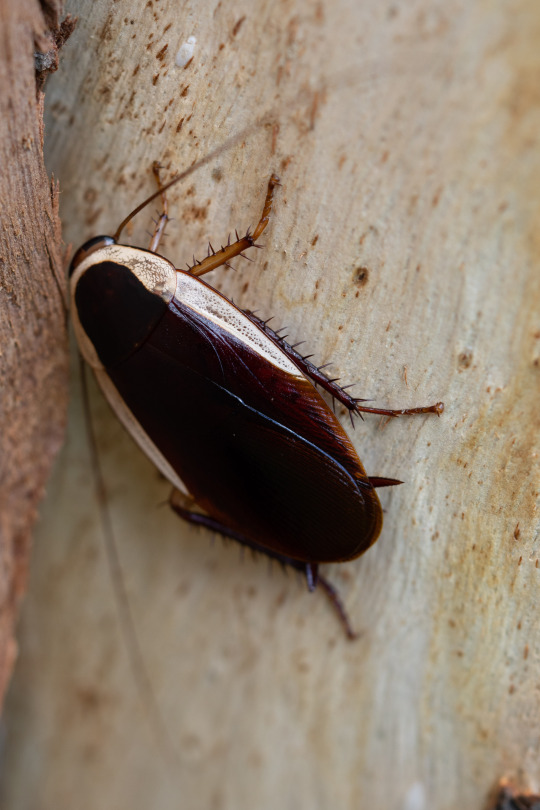
exquisite creature chilling under some gumtree bark.

Unknown Cockroach (genus Methana).
#ljsbugblog#bugblr#entomology#macro#insects#blattodea#cockroaches#blattidae#household cockroaches#methana#unconfirmed id
943 notes
·
View notes
Text
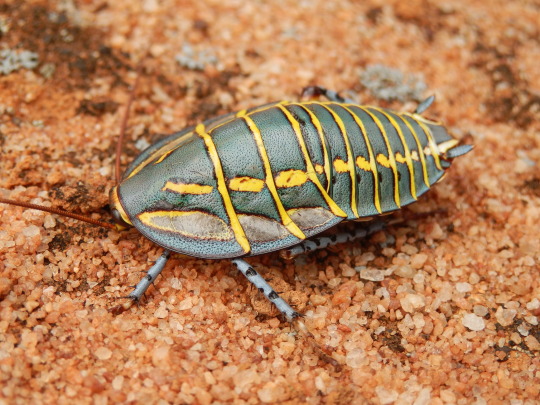
Mitchell's Diurnal Cockroach (Polyzosteria mitchelli), family Blattidae, order Blattodea, Bunjil, Western Australia
photograph by v_winter
430 notes
·
View notes
Text
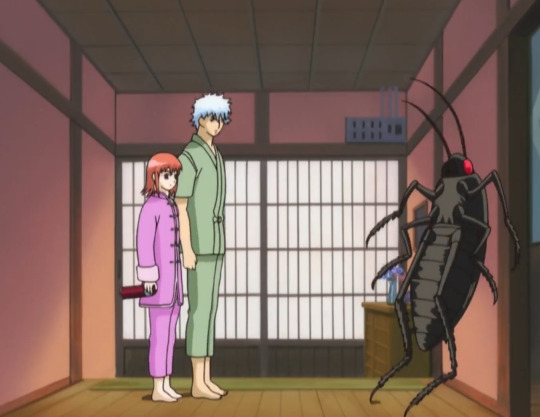
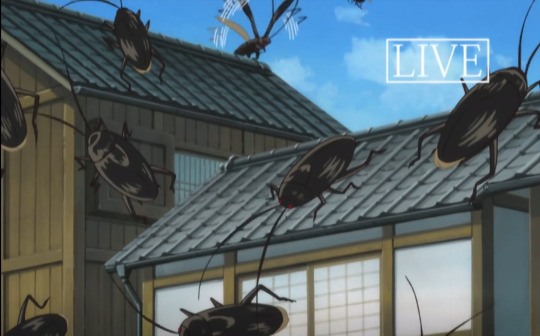

Today’s anime insects of the day are: the giant cockroaches from Gintama
Order: Blattodea
Family: Blattidae(?)
135 notes
·
View notes
Text

An American cockroach (Periplaneta americana) nymph in Pattaya, Thailand
by Len Worthington
#i know they're a pest but to me the american cockroach is a very beautiful bug#american cockroach#cockroaches#juvenile#periplaneta americana#periplaneta#blattidae#blattodea#insecta#arthropoda#wildlife: thailand#wildlife: asia#invasive species
27 notes
·
View notes
Text
la cucaracha methana
24 notes
·
View notes
Text
#2566 - Celatoblatta sp. - Hooded Cockroach

A genus of Blattid roach found in Australia, New Zealand and New Caledonia, although it's likely the genus will need to be broken up. The 14 NZ species seem to be a genuine grouping, though.
The New Zealand Celatoblatta are all flightless and most live in forest, but four live above the tree line. The Otago alpine cockroach Celatoblatta quinquemaculata can survive freezing down to -9 °C - quite a rare ability.
St Arnaud, Southern Alps, New Zealand
1 note
·
View note
Photo



Female harlequin cockroaches with oothecae (egg cases), Neostylopyga rhombifolia,Blattidae
Photo 1 by william91803, 2 byhydrophilus, and 3 by armandoaraniegues
#animals#curators on tumblr#insects#bugs#cockroach#roach#harlequin cockroach#egg case#ootheca#one nice bug
446 notes
·
View notes
Text
cockroaches have always been a group I hold in high esteem among the insects, and I saw a lot of nice ones in Singapore & Malaysia this past summer.
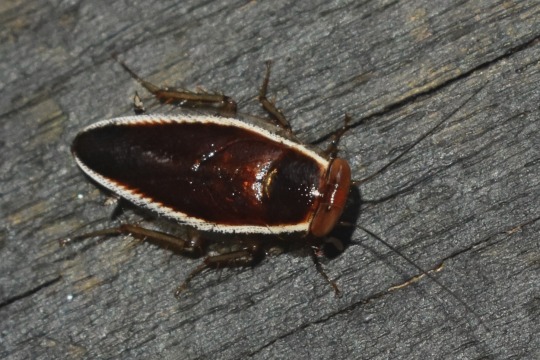
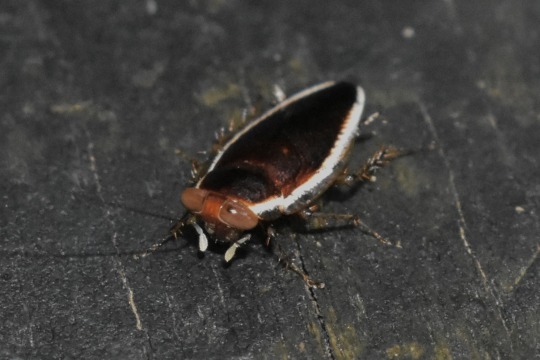
first is the tiny Pseudophyllodromia laticeps, whose name means ‘broad-headed’ but really most of its head are huge eyes! unlike the rest of these cockroaches, which are nocturnal, these flit around in daylight like houseflies and are just as quick to take flight when approached.

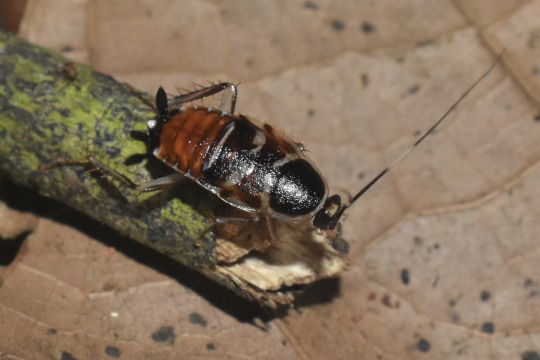
I’m not fully sure what these next two are, perhaps blatellids.
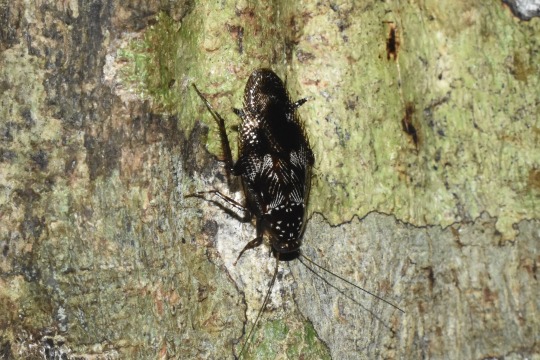
Allacta is another pseudophyllodromiid and a very charming one, with delicate white markings on a shiny black background.
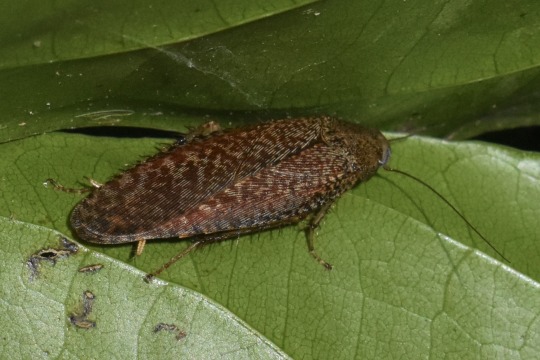
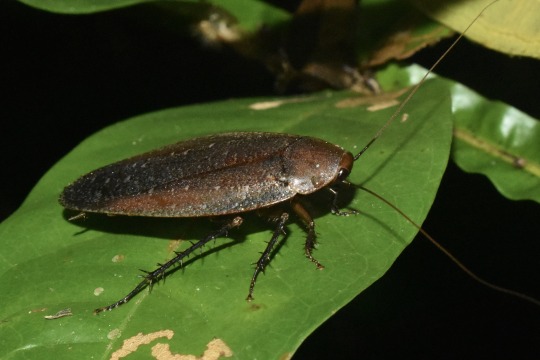
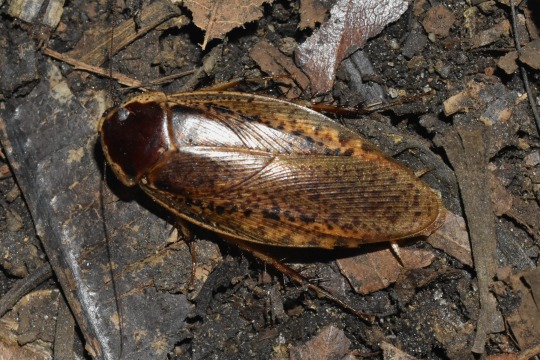
epilamprines are a lovely group of blaberid cockroaches that are diverse in the area; these three were Rhabdoblatta of three different species. the last one there was probably the prettiest roach I saw on the trip; sadly it was found dead on the path.
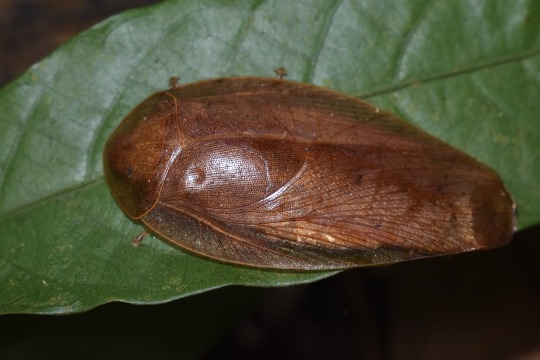
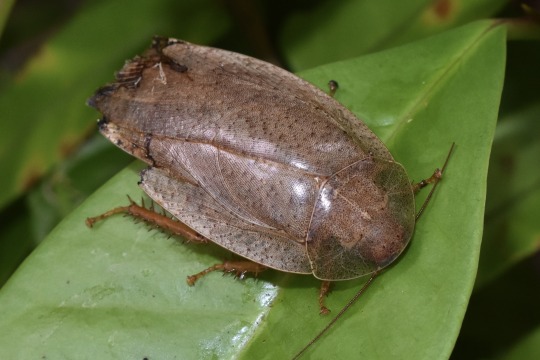
Pseudophorapsis nebulosa is a big epilamprine that tucks away its appendages and resembles a dead leaf during the day.
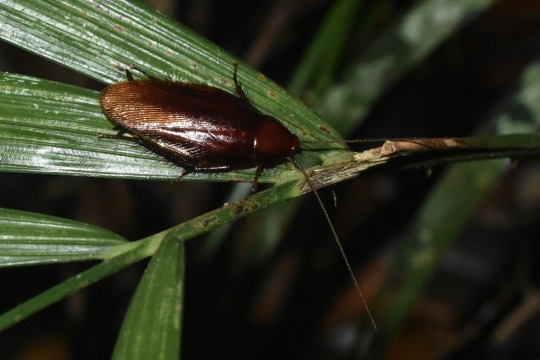
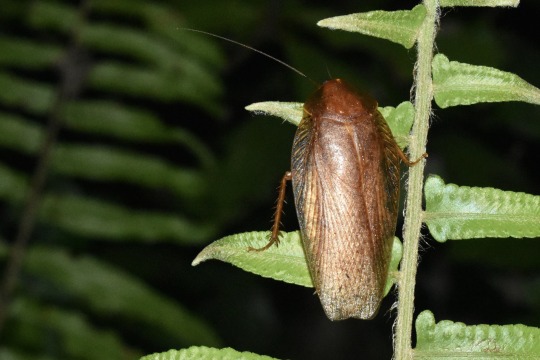
I’m not sure what these next two were, possibly more blaberids?
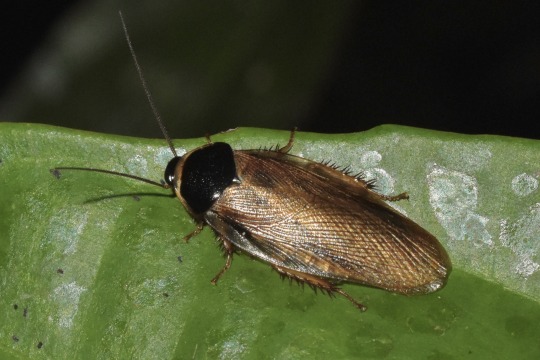
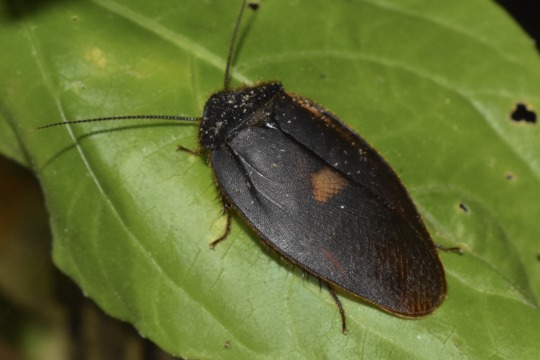
a male Pycnoscelus indicus was a nice sight—while very common, I’m only used to seeing female Pycnoscelus surinamensis, which descends directly from that species! several lineages of P. indicus independently developed the ability to clone themselves instead of mating; these female-only strains are together known as P. surinamensis.
the roach on the right is Ergaula pilosa, a cute burrowing cockroach (Corydiidae).


these two nonnative species need no introduction: Periplaneta australasiae and Periplaneta americana (Blattidae), two species that are big “pest” roaches worldwide. these two were just chilling in the forest, however.
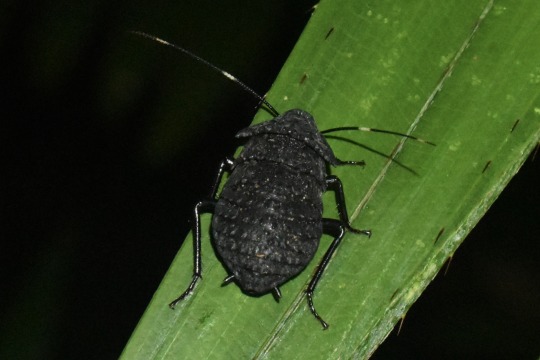
blattids are a funny group since one bunch are all “pest roach-y” (the blattines above) but the rest are strictly outdoor species ranging from wildly colorful Australian forms to bumpy, ornate archiblattines like this Catara rugosicollis. I missed getting photos of another lovely species, Protagonista pertristis, which sprayed my hands with an eye-wateringly-powerful scent of oranges before making her escape into the leaf litter.
750 notes
·
View notes
Note
isss it true that roaches can survive radiation
i had to do a bunch of cross-reffing w sources on radioresistance for this so idk everyrhin but from what I've read they are very resistant to acute radiation! they can survive a relatively for their species long time after receiving large doses of radiation, but are still really weak to residual (?) radiation or more bursts, and over time after exposure it takes less n less radiation for it to be lethal, enuff that its around halved after a couple weeks! but they are still very resilient lil buddies ^^
(also most research for this is done to house pest roaches like the american or german cockroach so this couldddd be moreso the case for the blattidae family of cockroaches specifically imo but idk)
#ty for asking c: genuinely ♡#i wus gunna hide but i did too much lookin into/rememberin shit abt roaches i gotta#do this first#infestations
18 notes
·
View notes
Text
in the end, the blattidae always come out on top
5 notes
·
View notes
Text
The humble cockroach -
Survival of one wreath speck table insect, (poll ease pod din me Elmer Fudd speak) thus earning hardy laurels nsync with inxs of standing kudos ranking as bajillion year old species scientific name: Periplaneta americana (Linnaeus) Insecta: Blattodea: Blattidae) throve for more than 300 million years, not surprisingly they constitute one of the oldest groups of insects on the earth. Longevity of twittering, skittering, and buzzfeeding critters survival witnessed their collective essence being gifted with best in class adaptation techniques particularly with debut appearance of naked ape slowly evolving into modern (wo)man, (after God - somewhat cagily took a rib from Adam), who when not resembling a rolling stone, nor asking sympathy for the devil furiously drove beasts of burden into dire straits down to the waterline. Much as yours truly feels squeamish about the the humble cockroach, (who most likely piggybacked as stowaway courtesy unbeknownst to people and hitched a ride across all four corners of the webbed wide world essentially becoming globetrotters), I chose said topic to broach as an object lesson how one creature
namely aforementioned adaptable creepy crawly creature made themselves quite at home raiding the pantries and refrigerators across wide stratification of income earners, not exclusively the purview solely nor singularly circumscribed and described by under-resourced people most often found
living and reproducing in cluttered city streets, parks, subway tunnels, and sewer systems— as well as inside houses and ramshackle buildings frequently woebegone tenements not strictly linkedin with Norwegian bachelor farmers but also make cameo appearances inside the coiffed hair of trumpeting dons subsequently hobnobbing with glitterati. German cockroaches are known for their prolific reproduction, with a female capable of producing up to 4 to 6 egg cases (oothecae) in her lifetime, each containing around 30 to 40 eggs. Under optimal conditions, they can go from egg to reproductive adult in as little as 100 days.
Cockroaches prefer dark places because they are nocturnal, so you will barely see them during the day. Hence, you will see them scuttle to hide when you turn on the basement or bathroom lights.
Thus yours truly attests to become easily spooked
out of his skin, and prone to utter bejesus then subsequently and immediately apt to swoon into a heap
of lovely bones
after espying a fast moving dark shape(s) videre licet pronouncing exaggerated silhouette cast courtesy moon shadow outsize profile shimmying and shaking
across the outer limits of the twilight zone
delineated by structures of silence.
Imagine dragons exudation regarding fiery breath,
which scary scene would not faze me in the least,
cuz I would whip out my handy dandy blue's clues and extinguish flaming forks courtesy water hose.
0 notes
Note
Any colorful roaches?
Colorful Cockroaches:
Of course my little chipmunk, lets see what I have...

Ball Cockroache (Perisphaerus spp.), family Blaberidae, Singapore
L - exuvia (shed exoskeleton) R - actual cockroach
photograph by Melvin Yeo

Mitchell’s Diurnal Cockroach (Polyzosteria mitchelli), family Blattidae, order Blattodea, Bunjil, Western Australia
photograph by v_winter

Eunyctibora bicolor, family Ectobiidae, Peru
photograph by Geoff Gallice


Cloud Forest Cockroach (Paratropes cf. bilunata), family Ectobiidae, Costa Rica
photograph by Matthew Kritzer

Ladybird Mimic Cockroach (Prosoplecta sp.), family Ectobiidae, Los Baños, Luzon, Philippines
photograph by George Beccaloni

Eushelfordia pica, family Ectobiidae, Ecuador
photograph by Andreas Kay
447 notes
·
View notes
Text
my entom professor complains about us doing poorly on the exam as if he did not teach us saying shit like. blattidae looks like a normal cockroach. psyllidae looks like a tiny cicada. sir how do i tell them apart from other families
1 note
·
View note
Link
0 notes